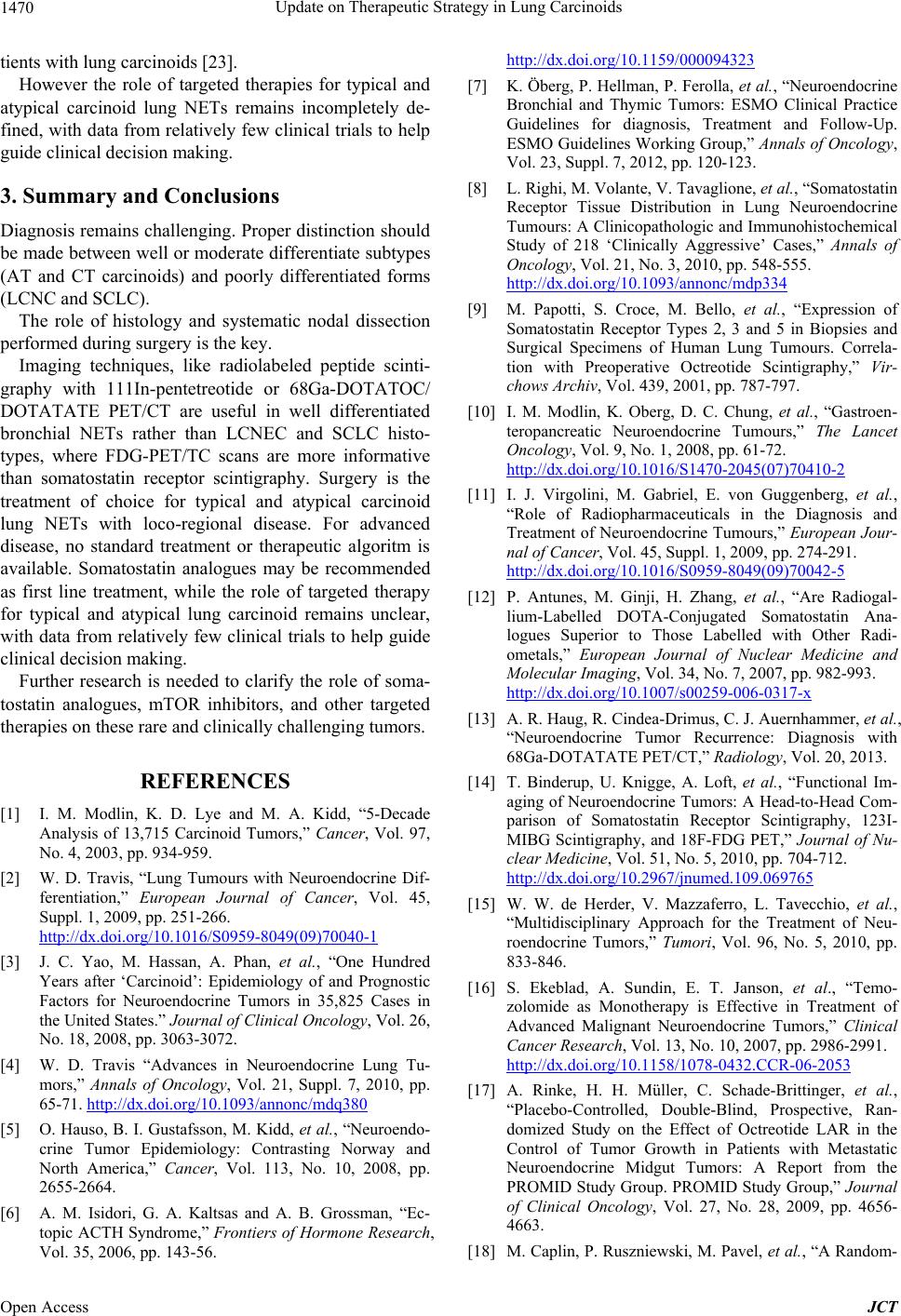
Update on Therapeutic Strategy in Lung Carcinoids
1470
tients with lung carcinoids [23].
However the role of targeted therapies for typical and
atypical carcinoid lung NETs remains incompletely de-
fined, with data from relatively few clinical trials to help
guide clinical decision making.
3. Summary and Conclusions
Diagnosis remains challenging. Proper distinction sh ould
be made between well or moderate differentiate subtypes
(AT and CT carcinoids) and poorly differentiated forms
(LCNC and SCLC).
The role of histology and systematic nodal dissection
performed during surgery is the key.
Imaging techniques, like radiolabeled peptide scinti-
graphy with 111In-pentetreotide or 68Ga-DOTATOC/
DOTATATE PET/CT are useful in well differentiated
bronchial NETs rather than LCNEC and SCLC histo-
types, where FDG-PET/TC scans are more informative
than somatostatin receptor scintigraphy. Surgery is the
treatment of choice for typical and atypical carcinoid
lung NETs with loco-regional disease. For advanced
disease, no standard treatment or therapeutic algoritm is
available. Somatostatin analogues may be recommended
as first line treatment, while the role of targeted therapy
for typical and atypical lung carcinoid remains unclear,
with data from relatively few clinical trials to help guide
clinical decision making.
Further research is needed to clarify the role of soma-
tostatin analogues, mTOR inhibitors, and other targeted
therapies on these rare and clinically challenging tumors.
REFERENCES
[1] I. M. Modlin, K. D. Lye and M. A. Kidd, “5-Decade
Analysis of 13,715 Carcinoid Tumors,” Cancer, Vol. 97,
No. 4, 2003, pp. 934-959.
[2] W. D. Travis, “Lung Tumours with Neuroendocrine Dif-
ferentiation,” European Journal of Cancer, Vol. 45,
Suppl. 1, 2009, pp. 251-266.
http://dx.doi.org/10.1016/S0959-8049(09)70040-1
[3] J. C. Yao, M. Hassan, A. Phan, et al., “One Hundred
Years after ‘Carcinoid’: Epidemiology of and Prognostic
Factors for Neuroendocrine Tumors in 35,825 Cases in
the United States.” Journal of Clinical Oncology, Vol. 26,
No. 18, 2008, pp. 3063-3072.
[4] W. D. Travis “Advances in Neuroendocrine Lung Tu-
mors,” Annals of Oncology, Vol. 21, Suppl. 7, 2010, pp.
65-71. http://dx.doi.org/10.1093/annonc/mdq380
[5] O. Hauso, B. I. Gustafsson, M. Kidd, et al., “Neuroendo-
crine Tumor Epidemiology: Contrasting Norway and
North America,” Cancer, Vol. 113, No. 10, 2008, pp.
2655-2664.
[6] A. M. Isidori, G. A. Kaltsas and A. B. Grossman, “Ec-
topic ACTH Syndrome,” Frontiers of Hormone Research,
Vol. 35, 2006, pp. 143-56.
http://dx.doi.org/10.1159/000094323
[7] K. Öberg, P. Hellman, P. Ferolla, et al. , “Neuroendocrine
Bronchial and Thymic Tumors: ESMO Clinical Practice
Guidelines for diagnosis, Treatment and Follow-Up.
ESMO Guidelines Working Group,” Annals of Oncology,
Vol. 23, Suppl. 7, 2012, pp. 120-123.
[8] L. Righi, M. Volante, V. Tavaglione, et al., “Somatostatin
Receptor Tissue Distribution in Lung Neuroendocrine
Tumours: A Clinicopathologic and Immunohistochemical
Study of 218 ‘Clinically Aggressive’ Cases,” Annals of
Oncology, Vol. 21, No. 3, 2010, pp. 548-555.
http://dx.doi.org/10.1093/annonc/mdp334
[9] M. Papotti, S. Croce, M. Bello, et al., “Expression of
Somatostatin Receptor Types 2, 3 and 5 in Biopsies and
Surgical Specimens of Human Lung Tumours. Correla-
tion with Preoperative Octreotide Scintigraphy,” Vir-
chows Archiv, Vol. 439, 2001, pp. 787-797.
[10] I. M. Modlin, K. Oberg, D. C. Chung, et al., “Gastroen-
teropancreatic Neuroendocrine Tumours,” The Lancet
Oncology, Vol. 9, No. 1, 2008, pp. 61-72.
http://dx.doi.org/10.1016/S1470-2045(07)70410-2
[11] I. J. Virgolini, M. Gabriel, E. von Guggenberg, et al.,
“Role of Radiopharmaceuticals in the Diagnosis and
Treatment of Neuroendocrine Tumours,” European Jour-
nal of Cancer, Vol. 45, Suppl. 1, 2009, pp. 274-291.
http://dx.doi.org/10.1016/S0959-8049(09)70042-5
[12] P. Antunes, M. Ginji, H. Zhang, et al., “Are Radiogal-
lium-Labelled DOTA-Conjugated Somatostatin Ana-
logues Superior to Those Labelled with Other Radi-
ometals,” European Journal of Nuclear Medicine and
Molecular Imaging, Vol. 34, No. 7, 2007, pp. 982-993.
http://dx.doi.org/10.1007/s00259-006-0317-x
[13] A. R. Haug, R. Cindea-Drimus, C. J. Auernhammer, et al.,
“Neuroendocrine Tumor Recurrence: Diagnosis with
68Ga-DOTATATE PET/CT,” Radiology, Vol. 20, 2013.
[14] T. Binderup, U. Knigge, A. Loft, et al., “Functional Im-
aging of Neuroendocrine Tumors: A Head-to-Head Com-
parison of Somatostatin Receptor Scintigraphy, 123I-
MIBG Scintigraphy, and 18F-FDG PET,” Journal of Nu-
clear Medicine, Vol. 51, No. 5, 2010, pp. 704-712.
http://dx.doi.org/10.2967/jnumed.109.069765
[15] W. W. de Herder, V. Mazzaferro, L. Tavecchio, et al.,
“Multidisciplinary Approach for the Treatment of Neu-
roendocrine Tumors,” Tumori, Vol. 96, No. 5, 2010, pp.
833-846.
[16] S. Ekeblad, A. Sundin, E. T. Janson, et al., “Temo-
zolomide as Monotherapy is Effective in Treatment of
Advanced Malignant Neuroendocrine Tumors,” Clinical
Cancer Research, Vol. 13, No. 10, 2007, pp. 2986-2991.
http://dx.doi.org/10.1158/1078-0432.CCR-06-2053
[17] A. Rinke, H. H. Müller, C. Schade-Brittinger, et al.,
“Placebo-Controlled, Double-Blind, Prospective, Ran-
domized Study on the Effect of Octreotide LAR in the
Control of Tumor Growth in Patients with Metastatic
Neuroendocrine Midgut Tumors: A Report from the
PROMID Study Group. PROMID Study Group,” Journal
of Clinical Oncology, Vol. 27, No. 28, 2009, pp. 4656-
4663.
[18] M. Caplin, P. Ruszniewski, M. Pavel, et al., “A Random-
Open Access JCT